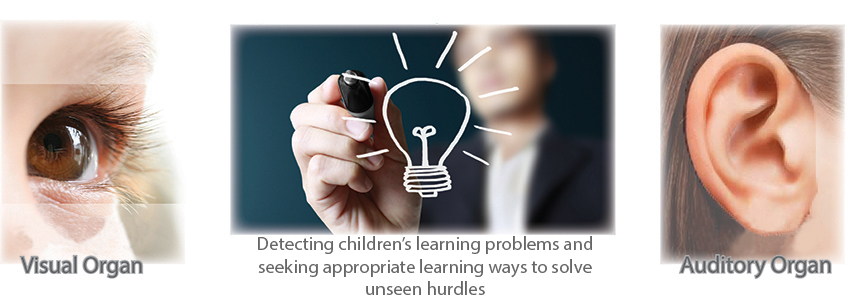

Multi sensory training—To promote the interaction and communication between the left and right halves of the brain intelligent foundation course applies the coordination of vision and auditory with the participation of echoic memory and the spatial touch by hands to facilitate the interaction and communication between the left and right hemispheres of the brain. It puts the whole brain in a stable state and enhances the direction and duration of thinking process. Thus, the abilities in—analysis—judgment—reasoning—observation will be enhanced.
Visual perception—Visual spatial skills can be separated into two main categories, visual perception and visual-motor integration. Visual perception is the ability to understand what is seen. It allows us to find things, notice differences between items and remember things we have seen. Visual–motor integration is the ability to coordinate what you see with body movements. Copying text from the board or from a book is another task that requires efficient visual—motor integration since the child shifts his gaze from far to near or from the book at his side to the paper in front of him. Weaknesses in visual–spatial skills can lead to academic difficulties in areas such as—reading—handwriting—spelling—maths. Children with visual–spatial weaknesses may struggle with—colouring—assembling puzzles—manipulating fasteners—tying shoes. Sometimes, their social skills are affected as well since they misinterpret nonverbal communication signals such as facial expressions and body language.
Eye tracking and dyslexia—Visual tracking is defined as efficiently moving the eyes from left to right or focusing on an object as it moves across a person’s visual field. This skill is important for almost all daily activities including—reading—writing—copying—drawing—playing. Thus, children with eye tracking problems often struggle in school because they always lose their place, skip or transpose words and have difficulty comprehending. They can’t accurately move their eyes across a page and tend to use their fingers to track words. This can also make reading a more uncomfortable and tiring process. There have been many reports of dyslexic people suffering from this problem. This may explain some of the classic symptoms of dyslexia, such as text blurring, letter reversal and missing out words when reading.
Hand eye coordination—Visual motor integration, commonly called hand—eye coordination, is the ability of the vision system to coordinate the information received through the eyes to control the hands to perform a task. Hand—eye coordination affects our ability to colour, draw pictures, solve mazes, write by hand, catch a ball, put a puzzle together, tie the shoelaces, button a shirt, build with blocks, thread a needle, use scissors and etc.
Fine motor skills—The abilities required to control the smaller muscles of the body for writing, playing an instrument, buttoning a shirt, tying the shoelaces and craft work. Fine motor skills are also associated with reading and writing, thus a child with poor hand—eye coordination may have poor handwriting and take longer to complete homework.
Gross motor skills—The abilities required to control the large muscles of the body for—walking—running—balancing—sitting upright—rolling over—throwing a bal—crawling and other activities.
Auditory memory—Auditory memory refers to the ability to store and recall auditory information. The ability to learn from oral instructions is a fundamental skill in our daily lives. However, children with weak auditory memory may have trouble understanding what words mean and even show a delayed grasp of language. Auditory memory is very important for learning. This is because learning requires auditory memory for children to remember word sounds and piece them together to form words. As we know, the auditory system is crucial for the development of language. Children with auditory memory deficits have difficulty interpreting the messages.
Spatial memory—Spatial memory refers to the encoding, storage and retrieval of information regarding the characteristics of space in one’s environment. It is a cognitive process that enables a person to remember different locations as well as spatial relations among objects. The ability is a critical skill in reading, maths and handwriting. A child must be able to recognize the different symbols, tell the difference between similar shapes and perceive their direction.
Visual memory—Visual memory refers to the recollection of visual information. It is also an important part of perceptual skill. It helps us recall information such as letters, numbers, words and pictures seen. When learning to read and write, a child has to remember what they read and recognize the words. If a child has difficulties with this skill, they may struggle to copy work from the board or a book because they can’t remember the words or sentences. There are two main types of memory.
—Short term memory—Retains information for a short period of time.
—Long term memory—Stores indefinite amount of information.
Visual discrimination—Visual discrimination refers to the ability to differentiate one object from another. This skill plays a tremendous role in learning for children of all ages. It lets us see differences between objects that are similar. For the tasks of reading and writing, children need to distinguish between the various symbols that comprise our written language. Children who have visual discrimination disorders often mix up letters or numbers and have difficulty reading or scanning pictures for information. Besides, there are very slight differences in many letters (b, d, and p) and numerals (6 and 9), so it is important for children to have finely developed visual discrimination skills to enable them to differentiate the distinctive features of forms including shape, orientation, size and colour.
 Malaysia
Malaysia England
England USA
USA China
China Taiwan
Taiwan Cambodia
Cambodia Singapore
Singapore Thailand
Thailand Indonesia
Indonesia Saudi Arabia
Saudi Arabia Vietnam
Vietnam Russian
Russian Korea
Korea Japan
Japan Turkey
Turkey French
French Netherlands
Netherlands Italy
Italy Germany
Germany Portugal
Portugal Playtime–1
Playtime–1  Playtime–2
Playtime–2  Playtime–3
Playtime–3  Playtime–4
Playtime–4  Holidays
Holidays Student Awards
Student Awards Instructor Awards
Instructor Awards Centre Awards
Centre Awards


